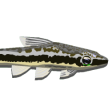| Scientific Name | Hypancistrus debilittera Armbruster, Lujan & Taphorn, 2007 |
| Common Names | L129, Colombian Zebra Pleco Colombiansk Zebramalle (Denmark) |
| Type Locality | Pasaganado, 38 kilometers north of San Fernando de Atabapo, 4°23'04''N, 67°46'28''W, Río Orinoco, Amazonas, Venezuela |
| Pronunciation | hype an siss truss |
| Etymology | A contraction of the Greek hypo (meaning less than) and ancistrus, an allusion to the reduced number of teeth (particularly in the lower jaw) found in this genus. A combination of the Latin debilis meaning weak and littera meaning letter, in reference to the weak or absent E on the snout. |
| Size | 70mm or 2.8" SL. Find near, nearer or same sized spp. |
| Identification | Dark brown base coloration with fine yellowish stripe. Rather large eyes compared with the body length (like Hypancistrus inspector. A small mouth with typical Hypancistrus dentition. |
| Sexing | Typical of the genus; males have longer pectoral and interopercular odontodes, they also have plate odontodes on the body. Females are rounder in the ventral region. |
| Distribution | South America: Río Orinoco in Venezuela. Orinoco, Middle Orinoco, Bita (click on these areas to find other species found there) Login to view the map. |
| IUCN Red List Category | Least Concern , range map and more is available on the IUCN species page. Last assessed 2020. |
| pH | 6.4 - 7.6 |
| Temperature | 24.0-28.0°C or 75.2-82.4°F (Show species within this range) |
| Feeding | Omnivore. They still seem to prefer meaty foods such as blood worms, gammarus or brine shrimps. Commercially prepared food such as Spirulina tabs are also eaten. User data. |
| Furniture | Fine sand, driftwood, slate and/or bamboo caves. Plants can be kept without fear of damage from this species. |
| Compatibility | Its small size makes it a good citizen for small tanks. Males are more territorial than females and are territorial toward conspecifics and other Loricariidae of about the same size. |
| Suggested Tankmates | Small tetras and other similar small fish. Also Corydoras. Care has to be taken to ensure that they get enough food, as they can be a bit shy and slow to grab food when available. |
| Breeding | Females lay about 20 eggs of about 3mm in diameter in a cave. Brood guarded by the male in the cave. Raising of the young is unproblematic if a good hygiene is provided. |
| Breeding Reports | There are 14 breeding reports, read them all here. |
| Reference | Copeia 2007 (no. 1), pp 68, Figs. 1D, 5. |
| Registered Keepers | There are 237 registered keepers, view all "my cats" data. |
| Wishlists | Love this species? Click the heart to add it to your wish list. There are 16 wishes to keep this species, see who wants what. |
| Spotters | Spotted this species somewhere? Click the binoculars! There are 95 records of this fish being seen, view them all. |
| Forum BBCode | |
| Search for H. debilittera | |
| Look up H. debilittera on AquaticRepublic.com | |
 | Look up H. debilittera on Fishbase |
 | Look up H. debilittera on Encyclopedia of Life |
 | Look up H. debilittera on Global Biodiversity Information Facility |
| LFS label creator ARN ref:1.4.7.211 | |
| Last Update | 2025 Jan 02 01:36 (species record created: 2001 May 05 00:00) |





/siluriformes/loricariidae/hypancistrus/debilittera/1.jpg)
/siluriformes/loricariidae/hypancistrus/debilittera/2.jpg)
/siluriformes/loricariidae/hypancistrus/debilittera/3.jpg)
/siluriformes/loricariidae/hypancistrus/debilittera/4.jpg)
/siluriformes/loricariidae/hypancistrus/debilittera/5.jpg)
/siluriformes/loricariidae/hypancistrus/debilittera/6.jpg)
/siluriformes/loricariidae/hypancistrus/debilittera/7.jpg)
/siluriformes/loricariidae/hypancistrus/debilittera/8.jpg)
/siluriformes/loricariidae/hypancistrus/debilittera/9.jpg)
/siluriformes/loricariidae/hypancistrus/debilittera/10.jpg)
/siluriformes/loricariidae/hypancistrus/debilittera/11.jpg)
/siluriformes/loricariidae/hypancistrus/debilittera/12.jpg)
/siluriformes/loricariidae/hypancistrus/debilittera/13.jpg)
/siluriformes/loricariidae/hypancistrus/debilittera/14.jpg)
/siluriformes/loricariidae/hypancistrus/debilittera/15.jpg)
/siluriformes/loricariidae/hypancistrus/debilittera/16.jpg)
/siluriformes/loricariidae/hypancistrus/debilittera/17.jpg)
/siluriformes/loricariidae/hypancistrus/debilittera/18.jpg)
/siluriformes/loricariidae/hypancistrus/debilittera/19.jpg)